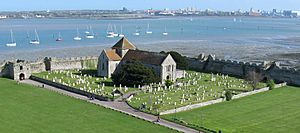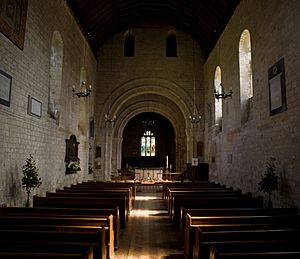Southwick Priory facts for kids
| Monastery information | |
|---|---|
| Full name | Our Lady of Southwick |
| Established | 1133 |
| Disestablished | 7 April 1538 |
| People | |
| Founder(s) | Henry I |
| Site | |
| Location | Portchester and Southwick, Hampshire, England |
| Visible remains | Church at Portchester, one wall and earthworks at Southwick |
| Public access | To churches |
Southwick Priory or Our Lady at Southwick was a monastery for Augustinian canons (a type of religious community). It was first built inside Portchester Castle near Portsmouth Harbour. Later, it moved about 2 miles north to Southwick, Hampshire, England. The priory stopped existing in 1538 during a time called the Dissolution of the Monasteries.
Contents
How Southwick Priory Started
In 1133, King Henry I created a priory for Austin canons. It was located in the church of St. Mary inside Portchester Castle. The King's official document gave the canons the church and land. They also received wood for building and fuel, and a place for their animals to graze.
The priory also got a large area of land called the manor of Candover. They also received a small piece of land in both Southwick and Applestead. By the early 1200s, official papers started calling it Southwick Priory. People believe it moved to the Southwick site between 1145 and 1153.
From the 1200s to the 1500s
As the Middle Ages came to an end, the priory became a famous place for pilgrimage. This meant many people traveled there for religious reasons. In September 1510, King Henry VIII visited Southwick. He made an offering at the shrine of Our Lady of Southwick.
In 1538, just before the priory closed, a man named John Husee wrote about it. He said that famous pilgrimage sites like Our Lady of Southwick were losing their popularity. Another writer, Leland, also mentioned how well-known the pilgrimage to Our Lady of Southwick was.
By the time the priory closed, it owned many lands. These included the manors of Southwick, Newland, Hannington, and Sutton Scotney. They also owned churches in places like Nutley, Portsmouth, and Portsea. The priory had many properties and collected rents from them.
The Priory Closes Down
In 1535, a survey called the Valor Ecclesiasticus looked at the priory's money. It said the priory earned about £257 each year. However, one of the canons, James Gunwyn, wrote a letter in 1536. He told Thomas Cromwell that some rules were not being followed. He also mentioned that the prior (the head of the priory) might hide valuable items if he knew about the letter.
On March 16, 1538, a letter said the priory would be closed. It also mentioned that the statue of 'Our Lady of Southwick' was taken down. On April 7, 1538, the prior, William Norton, and twelve canons officially signed papers to close the priory. James Gunwyn, who wrote the letter, also signed. Prior Norton received a large payment of £66 13s. 4d after the priory closed.
After the Priory Closed
After the priory closed, John White took ownership of it. He was a helper to Thomas Wriothesley, 1st Earl of Southampton. John White pulled down the church building. He turned the prior's living area and other parts of the monastery into a private house. This house was called Southwick Park. It became the main home for a part of the Norton family.
In October 1551, Mary of Guise, who was the Regent of Scotland and mother of Mary, Queen of Scots, stayed in the house. When John White died in 1567, his son Edward took over the manor. Edward died in 1580, and his son John White (who died in 1606) inherited it. Queen Elizabeth I visited the house on August 30, 1591. The next day, she rode to Portchester Castle.
In 1606, John White gave the manor to his daughter Honor. This happened when she married Sir Daniel Norton. They took control of the manor after John White died the next year.
What Remains Today
The church of St Mary at Portchester is still standing. It is inside the old Roman wall of Portchester Castle. This church is mostly a Norman building, meaning it's the same one the priory used at the very beginning. There are no other parts of the monastery buildings left above the ground there. You can only see some old drain openings and marks where the cloister (a covered walkway) used to connect to the church wall.
The house that was built using materials from the priory burned down in 1750. Its stones were then used for other things. Since 1838, a new building called Southwick House has been on the site. Today, it is home to the Defence School of Policing and Guarding. It also houses the main office for the Royal Military Police.
Of the Southwick Priory itself, only one part of a wall and some earthworks (changes in the ground) remain. Some pieces of the priory church might have been moved and used in the parish church of St James in Southwick. The large area of land around Southwick is still together and is known as the Southwick Estate.
|



